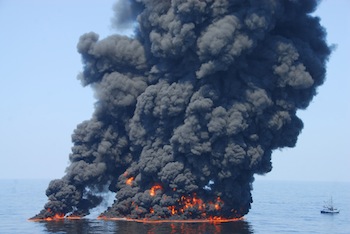A .gov website belongs to an official government organization in the United States.
A lock () or https:// means you've safely connected to the .gov website. Share sensitive information only on official, secure websites.
20 September 2011

During the 2010 Deepwater Horizon oil spill in the Gulf of Mexico, an estimated one of every 20 barrels of spilled oil was deliberately burned off to reduce the size of surface oil slicks and minimize impacts of oil on sensitive shoreline ecosystems and marine life. In response to the spill, NOAA quickly redirected its WP-3D research aircraft to survey the atmosphere above the spill site in June. During a flight through one of the black plumes, scientists used sophisticated instrumentation on board, including NOAA's single-particle soot photometer, to characterize individual black carbon particles.
The black smoke that rose from the water's surface during the controlled burns pumped more than 1 million pounds of black carbon (soot) pollution into the atmosphere, according to a new study published last week by researchers at NOAA and its Cooperative Institute for Research in Environmental Sciences (CIRES) in Boulder.
This amount is roughly equal to the total black carbon emissions normally released by all ships that travel the Gulf of Mexico during a 9-week period, scientists noted.
Black carbon, whose primary component is often called soot, is known to degrade air quality and contribute to warming of the Earth's atmosphere. The new study, published online this week in Geophysical Research Letters, provides some of the most detailed observations made of black carbon sent airborne by burning surface oil.
"Scientists have wanted to know more about how much black carbon pollution comes from controlled burning and the physical and chemical properties of that pollution. Now we know a lot more," said lead author Anne Perring, a scientist with CIRES and CSD.

Black carbon is the most light-absorbing airborne particle in the atmosphere and the reason for the black color in the smoky plumes that rise from the surface oil fires. Black carbon can also cause warming of the atmosphere by absorbing light. Prolonged exposure to breathing black carbon particles from human and natural burning sources is known to cause human health effects.
During the 9 weeks active surface oil burning, the study estimated a total of 1.4 to 4.6 million pounds (0.63 to 2.07 million kilograms) of black carbon was sent into the atmosphere of the Gulf of Mexico.
The study found that the hot soot plumes from the controlled burns reached much higher into the atmosphere than ship emissions normally rise, potentially prolonging the amount of time the black carbon can remain in the atmosphere, which would affect where the black carbon ends up.
The researchers also found that the average size of the black carbon particles was much larger than that emitted from other sources in the Gulf region, and that the emitted particles produced were almost all black carbon, unlike other sources such as forest fires that tend to produce other particles along with black carbon.
"The size and makeup of the black carbon particles determine how fast the particles are removed from the atmosphere by various processes, which ultimately affects their impact on climate," says Perring. Larger particles are removed from the atmosphere more quickly and thus have smaller climate impacts. And, those same properties of black carbon are important for assessing human health impacts.
Finally, Perring and her colleagues found that of the oil that was burned, 4 percent of the mass was released as black carbon, an important metric rarely observed during cleanup of an oceanic oil spill, which could help guide future decision-making.
The new paper "Characteristics of black carbon aerosol from a surface oil burn during the Deepwater Horizon oil spill" has 15 co-authors from CSD and CIRES.
A. E. Perring1,2, J. P. Schwarz1,2, J. R. Spackman1,2, R. Bahreini1,2, J. A. de Gouw1,2, R. S. Gao1, J. S. Holloway1,2, D. A. Lack1,2, J. M. Langridge1,2, J. Peischl1,2, A. M. Middlebrook1, T. B. Ryerson1, C. Warneke1,2, L. A. Watts1,2, D. W. Fahey1, Characteristics of black carbon aerosol from a surface oil burn during the Deepwater Horizon oil spill, Geophysical Research Letters, doi:10.1029/2011GL048356, 2011.
Black carbon (BC) aerosol mass mixing ratio and microphysical properties were measured from the NOAA P-3 aircraft during active surface oil burning subsequent to the Deepwater Horizon oil rig explosion in April 2010. Approximately 4% of the combusted material was released into the atmosphere as BC. The total amount of BC introduced to the atmosphere of the Gulf of Mexico via surface burning of oil during the 9-week spill is estimated to be (1.35 ± 0.72) x 106 kg. The median mass diameter of BC particles observed in the burning plume was much larger than that of the non-plume Gulf background air and previously sampled from a variety of sources. The plume BC particles were internally mixed with very little non-refractory material, a feature typical of fresh emissions from fairly efficient fossil-fuel burning sources and atypical of BC in biomass burning plumes. BC dominated the total accumulation-mode aerosol in both mass and number. The BC mass-specific extinction cross-section was 10.2 ± 4.1 and 7.1 ± 2.8 m2/g at 405 and 532 nm respectively. These results help constrain the properties of BC emissions associated with DWH and other large spills.